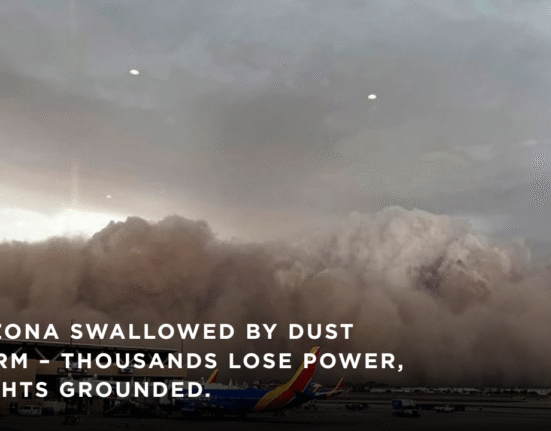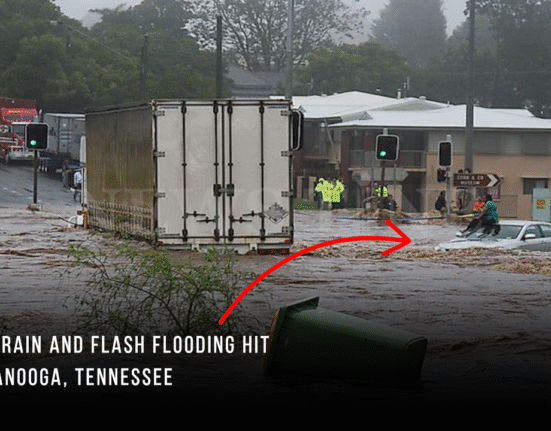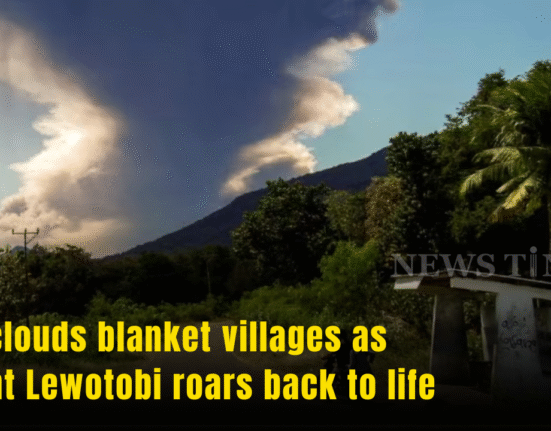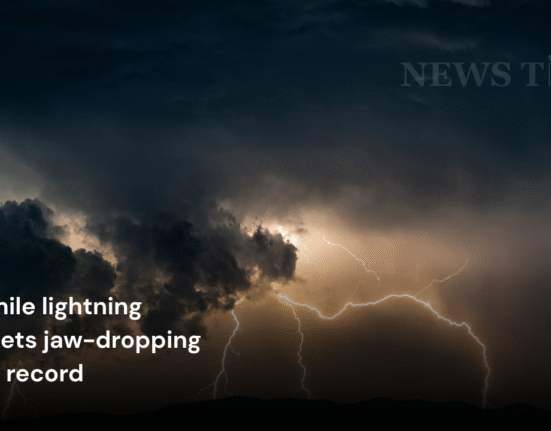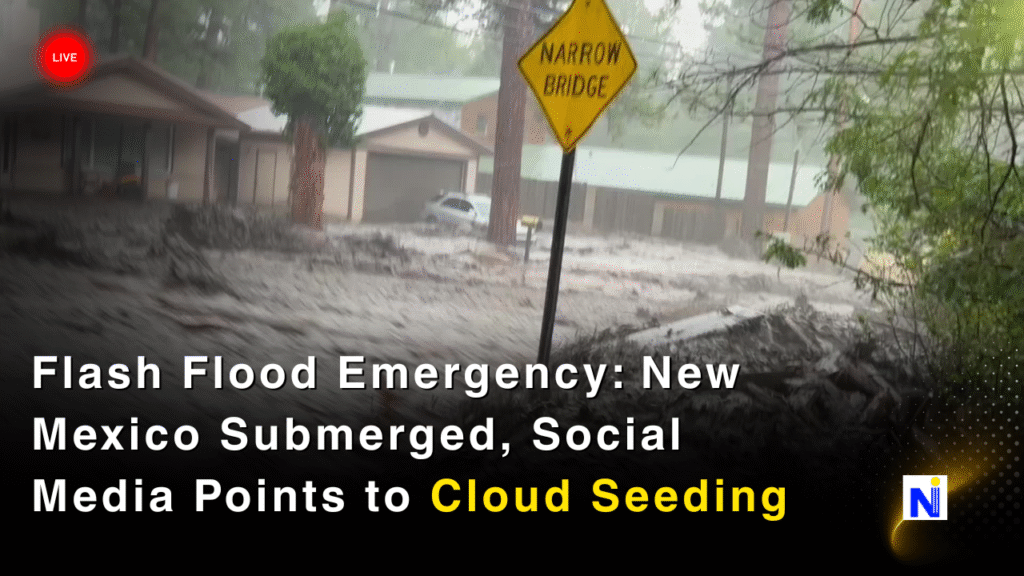
Floods don’t usually come with warning labels. They creep up in minutes, especially when nature goes into overdrive—as it did this week in New Mexico. On Tuesday, parts of Lincoln County, Ruidoso, and Hollywood were overwhelmed by violent flash floods that sent rivers surging and homes drifting downstream. In the aftermath, a new storm has brewed—online. Social media exploded with speculation, much of it linking the incident to a controversial practice: cloud seeding.
This incident marks the third major flooding event in the United States in less than seven days, following fatal flash floods in Texas and North Carolina. And now, the focus is on New Mexico flooding, a disaster that’s left residents reeling and the internet buzzing.
What Happened in New Mexico?
Flash Flood Timeline
- Date: Tuesday, July 8, 2025
- Affected Areas: Lincoln County, Ruidoso, Hollywood
- River Impacted: Rio Ruidoso
- Surge Data: Rose 20 feet in 30 minutes (NOAA)
According to the National Weather Service, the situation escalated rapidly. “Homes starting to be moved by water,” read a chilling alert issued around 4 p.m.
On-the-Ground Impact
Residents shared footage showing the Rio Ruidoso morphing from a calm stream into a violent torrent. Several homes were reported swept away. Emergency crews struggled to reach trapped residents as torrential rain washed over the region.
“It felt like the mountain just emptied itself into town,” said a resident of Ruidoso. “We had minutes—maybe less.”
A Week of Deadly Floods in the U.S.
| Date | Location | Deaths/Injuries | Key Event |
|---|---|---|---|
| July 4 | Hunt, Texas | 27+ dead, 6 missing | Flash flood at Camp Mystic summer camp |
| July 7 | Western North Carolina | Unknown | Heavy rainfall and flash flooding |
| July 8 | Ruidoso, New Mexico | No confirmed deaths | Rio Ruidoso rose 20 feet in 30 minutes |
Enter the Cloud Seeding Theories
Social media lit up soon after the floods, with users drawing connections between the timing of the floods and weather modification practices.
What Is Cloud Seeding?
Cloud seeding involves dispersing substances like silver iodide into clouds to stimulate rainfall. It’s a controversial form of weather modification, with limited but growing application worldwide.
New Mexico’s Cloud Seeding Program
In February 2024, the New Mexico House of Representatives passed a bill launching a pilot cloud seeding program in the state’s southeast region. The initiative aimed to boost precipitation to combat drought, not cause extreme flooding.
“This project was never intended for high-rainfall zones. It’s a drought mitigation tool,” said Dr. Maria Escobar, a climatologist at the University of New Mexico.
Social Media Comments Fueling the Theory
- “Domestic terrorism with cloud seeding? Just an idea. Texas. North Carolina. New Mexico… all within a week.”
- “New Mexico is one of the states doing cloud seeding. This isn’t a coincidence.”
- “If this has anything to do with cloud seeding, there needs to be an immediate halt on the weather modification!”
The Texas Tragedy: Camp Mystic’s Flood Nightmare
While New Mexico battled its floodwaters, Texas was still grappling with the devastation at Camp Mystic, an all-girls Christian summer camp in Hunt. The flood caught 557 campers and over 100 staff off-guard.
What Went Wrong at Camp Mystic?
- July 2: Camp inspected, found no deficiencies
- July 3: Flood watch issued at 1:18 p.m.
- July 4: River surged from 14 feet to 29.5 feet in under an hour
“People were clinging to trees,” one survivor said. “We didn’t even hear an alarm. We just saw the water.”
At least 27 lives were lost, including beloved camp director Richard “Dick” Eastland. Another five campers and one counselor are still missing.
Prepared or Not?
The Texas Department of State Health Services confirmed that Camp Mystic had emergency procedures in place—but those plans are not required to be filed with the state. They must only be posted inside buildings.
“We do not have them,” said state health spokesperson Lara Anton. “You’d have to get it from the camp.”
Rainfall Data
One nearby gauge recorded 9.5 inches of rain, while another showed 12.2 inches. USGS gauges failed in four key locations during the event.
| Gauge Location | Max River Level (ft) | Time |
| East of Hunt | 29.5 | 4:35 a.m. |
| High Water Estimate | 37.52 | Preliminary |
North Carolina’s Quiet Flooding
Not to be overlooked, North Carolina faced flash floods just a day before New Mexico’s deluge. While the damage was less severe, the incident added fuel to the cloud seeding conversation.
Debunking the Myth: Is Cloud Seeding to Blame?
While it’s easy to connect dots during a crisis, experts say there’s no evidence that the recent flooding events are connected to cloud seeding.
“It’s a classic case of post hoc fallacy,” said meteorologist Evan Wilkes. “Weather systems don’t recognize state borders, and heavy rainfall is typical during monsoon season.”
Key Facts:
- No scientific data connects current floods to seeding programs.
- Seeding targets specific clouds and usually requires ideal conditions.
- Flooding patterns match historical norms for this season.
Lessons from the Deluge
For Residents
- Stay Weather-Aware: Sign up for local alerts and invest in weather radios.
- Know Your Zone: Understand if you live in a flood-prone area.
- Have a Go-Bag: Essentials include water, first aid, flashlight, and charger.
For Lawmakers and Camp Operators
- Transparency: Share emergency plans publicly.
- Accountability: Improve real-time weather monitoring.
- Technology: Invest in robust alert systems.
Nature, Not Conspiracy
The New Mexico flooding, while terrifying, is likely part of a broader climatic pattern—not the result of secret weather experiments. That said, it’s clear that preparedness and communication can make all the difference.
Our hearts go out to all families affected across New Mexico, Texas, and North Carolina. Let’s use this moment not to fear the clouds—but to better understand them.



